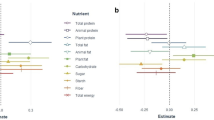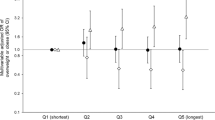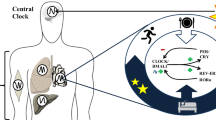Abstract
Background/Objectives:
Previous studies have shown that individuals with circadian preferences for the evening (wake up later and reach maximum activity in the afternoon) have distorted dietary habits and misregulated body weight. Therefore, the present study was conducted to analyse the possible relationships between ‘morningness’ or ‘eveningness’ (chronotype), dietary habits and the level of obesity.
Subjects/Methods:
Among 400 participants, 171 subjects finished the follow-up period and were evaluated. Anthropometric, clinical and dietary parameters were analysed; the Horne–Östberg test was used to determine chronotype. A hypocaloric-behavioural intervention was performed in the overweight/obese subjects.
Results:
In normal-weight subjects, the morningness group ingested most of their energy and nutrients at breakfast and lunch, whereas the eveningness group showed a higher intake at dinner, corresponding with their chronotypes. A significant interaction was revealed between chronotype and body mass index regarding the energy and nutrients consumed at dinner (P<0.05 in all cases), as in the normal-weight subjects the evening food intake was higher in the eveningness group, but in the overweight subjects the situation was inverse. In addition, the food preferences were related to the chronotype, as the morningness subjects showed a higher intake of fruit (P<0.010).
Conclusions:
The timing of food intake corresponded to the chronotype in the normal-weight subjects; however, the overweight/obese subjects showed intake patterns removed from their physiological rhythms. These findings may indicate a need to design specific diets based not only on the total energy expenditure but also on the chronotype, as an indicator of the biological rhythms.
This is a preview of subscription content, access via your institution
Access options
Subscribe to this journal
Receive 12 print issues and online access
$259.00 per year
only $21.58 per issue
Buy this article
- Purchase on Springer Link
- Instant access to full article PDF
Prices may be subject to local taxes which are calculated during checkout



Similar content being viewed by others
References
Gonnissen HKJ, Hulshof T, Westerterp-Plantenga MS . Chronobiology, endocrinology, and energy- and food-reward homeostasis. Obes Rev 2013; 14: 405–416.
Bravo R, Cubero J, Franco L, Mesa M, Galán C, Rodríguez AB et al. Body weight gain in rats by a high-fat diet produces chronodisruption in activity/inactivity circadian rhythm. Chronobiol Int 2014; 31: 363–370.
Oosterman JE, Kalsbeek A, la Fleur SE, Belsham DD . Impact of nutrients on circadian rhythmicity. Am J Physiol Regul Integr Comp Physiol 2015; 308: R337–R350.
Crino M, Sacks G, Vandevijvere S, Swinburn B, Neal B . The influence on population weight gain and obesity of the macronutrient composition and energy density of the food supply. Curr Obes Rep 2015; 4: 1–10.
Herichova I . Changes of physiological functions induced by shift work. Endocr Regul 2013; 47: 159–170.
Hernandez-Morante JJ, Gomez-Santos C, Milagro F, Campion J, Martinez JA, Zamora S et al. Expression of cortisol metabolism-related genes shows circadian rhythmic patterns in human adipose tissue. Int J Obes (Lond) 2009; 33: 473–480.
Arble DM, Bass J, Laposky AD, Vitaterna MH, Turek FW . Circadian timing of food intake contributes to weight gain. Obesity 2009; 17: 2100–2102.
Kanerva N, Kronholm E, Partonen T, Ovaskainen M-L, Kaartinen NE, Konttinen H et al. Tendency toward eveningness is associated with unhealthy dietary habits. Chronobiol Int 2012; 29: 920–927.
Salas-Salvadó J, Rubio MA, Barbany M, Moreno B . SEEDO 2007 consensus for the evaluation of overweight and obesity and the establishment of therapeutic intervention criteria]. Med Clin (Barc) 2007; 128: 184–196; quiz 1 p following 200.
Ritchie JD, Miller CK, Smiciklas-Wright H . Tanita foot-to-foot bioelectrical impedance analysis system validated in older adults. J Am Diet Assoc 2005; 105: 1617–1619.
Horne JA, Ostberg O . A self-assessment questionnaire to determine morningness-eveningness in human circadian rhythms. Int J Chronobiol 1976; 4: 97–110.
Martin-Moreno JM, Boyle P, Gorgojo L, Maisonneuve P, Fernandez-Rodriguez JC, Salvini S et al. Development and validation of a food frequency questionnaire in Spain. Int J Epidemiol 1993; 22: 512–519.
Pérez-Llamas F, Garaulet M, Herrero F, Palma JT, Pérez de Heredia F, Marín R et al. Multivalent informatics application for studies of the nutritional status of the population. Assessment of food intake. Nutr Hosp 2004; 19: 160–166.
Ellis EM, Kiviniemi MT, Cook-Cottone C . Implicit affective associations predict snack choice for those with low, but not high levels of eating disorder symptomatology. Appetite 2014; 77: 122–130.
Alberti KGMM, Zimmet P, Shaw J . Metabolic syndrome–a new world-wide definition. A consensus statement from the International Diabetes Federation. Diabet Med 2006; 23: 469–480.
Gargallo Fernández, Manuel M, Breton Lesmes I, Basulto Marset J, Quiles Izquierdo J, Formiguera Sala X et al. Evidence-based nutritional recommendations for the prevention and treatment of overweight and obesity in adults (FESNAD-SEEDO consensus document). The role of diet in obesity treatment (III/III). Nutr Hosp 2012; 27: 833–864.
Dapcich V, Salvador Castell G, Ribas Barba L, Pérez Rodrigo C, Aranceta Bartrina J, Serra Majem L, Guía de la alimentación saludable. Madrid: Sociedad Española de Nutrición Comunitaria; 2004. Available at: http://www.nutricioncomunitaria.org/es/noticia-documento/19 accessed on 12 May 2011.
Wang JB, Patterson RE, Ang A, Emond JA, Shetty N, Arab L . Timing of energy intake during the day is associated with the risk of obesity in adults. J Hum Nutr Diet 2014; 27 (Suppl 2), 255–262.
Garaulet M, Gómez-Abellán P, Alburquerque-Béjar JJ, Lee Y-C, Ordovás JM . Scheer FAJL. Timing of food intake predicts weight loss effectiveness. Int J Obes (Lond) 2013; 37: 604–611.
Leidy HJ, Ortinau LC, Douglas SM, Hoertel HA . Beneficial effects of a higher-protein breakfast on the appetitive, hormonal, and neural signals controlling energy intake regulation in overweight/obese, ‘breakfast-skipping,’ late-adolescent girls. Am J Clin Nutr 2013; 97: 677–688.
Rose AK, Hardman CA, Christiansen P . The effects of a priming dose of alcohol and drinking environment on snack food intake. Appetite 2015; 95: 341–348.
Salehi M, Kazemi A, Hasan Zadeh J . The effects of 6 isocaloric meals pattern on blood lipid profile, glucose, hemoglobin a1c, insulin and malondialdehyde in type 2 diabetic patients: a randomized clinical trial. Iran J Med Sci 2014; 39: 433–439.
Reutrakul S, Hood MM, Crowley SJ, Morgan MK, Teodori M, Knutson KL et al. Chronotype is independently associated with glycemic control in type 2 diabetes. Diabetes Care 2013; 36: 2523–2529.
Deshmukh-Taskar PR, Nicklas TA, O’Neil CE, Keast DR, Radcliffe JD, Cho S . The relationship of breakfast skipping and type of breakfast consumption with nutrient intake and weight status in children and adolescents: the National Health and Nutrition Examination Survey 1999-2006. J Am Diet Assoc 2010; 110: 869–878.
McHill AW, Melanson EL, Higgins J, Connick E, Moehlman TM, Stothard ER et al. Impact of circadian misalignment on energy metabolism during simulated nightshift work. Proc Natl Acad Sci USA 2014; 111: 17302–17307.
Galindo Muñoz JS, Jiménez Rodríguez D, Hernández Morante JJ . Diurnal rhythms of plasma GLP-1 levels in normal and overweight/obese subjects: lack of effect of weight loss. J Physiol Biochem 2015; 71: 17–28.
Arora T, Taheri S . Associations among late chronotype, body mass index and dietary behaviors in young adolescents. Int J Obes 2014; 39: 39–44.
Ross KM, Graham Thomas J, Wing RR . Successful weight loss maintenance associated with morning chronotype and better sleep quality. J Behav Med 2015; 39: 465–471.
Acknowledgements
We are grateful to all those who participated in the study. The present work was funded by the PMAFI/14/12 project, from the Support for Research Help Program of the Catholic University of Murcia.
Author information
Authors and Affiliations
Corresponding author
Ethics declarations
Competing interests
The authors declare no conflict of interest.
Additional information
Supplementary Information accompanies this paper on European Journal of Clinical Nutrition website
Rights and permissions
About this article
Cite this article
Muñoz, J., Cañavate, R., Hernández, C. et al. The association among chronotype, timing of food intake and food preferences depends on body mass status. Eur J Clin Nutr 71, 736–742 (2017). https://doi.org/10.1038/ejcn.2016.182
Received:
Revised:
Accepted:
Published:
Issue Date:
DOI: https://doi.org/10.1038/ejcn.2016.182
This article is cited by
-
Alignment between timing of ‘highest caloric intake’ and chronotype in relation to body composition during adolescence: the DONALD Study
European Journal of Nutrition (2024)
-
Chronotype is associated with eating behaviors, physical activity and overweight in school-aged children
Nutrition Journal (2023)
-
Is chronotype linked with adherence to the Mediterranean diet among adolescents? The EHDLA study
Pediatric Research (2023)
-
Evening chronotype is associated with severe NAFLD in obesity
International Journal of Obesity (2022)
-
Vitamin D and chronotype: is there any relationship in individuals with obesity?
Journal of Endocrinological Investigation (2022)



